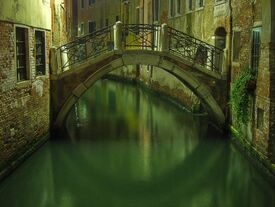Bridge: Difference between revisions
No edit summary |
No edit summary |
||
| (6 intermediate revisions by 2 users not shown) | |||
| Line 1: | Line 1: | ||
[[File:Venetian Bridge.jpg|275px|thumb|right|A Venetian bridge]] | |||
[[File:Venetian Bridge.jpg|275px|thumb|right|A Venetian | |||
''This article contains information about a typical Venetian bridge.'' {{For|a list of bridges|bridges}} | ''This article contains information about a typical Venetian bridge.'' {{For|a list of bridges|bridges}} | ||
A Venetian bridge (''ponte'' in Italian) is generally composed of an [[Masonry Bridge#Archways|arch]], a [[Bridge Wall|bridge wall]], and [[Bridge Step|steps]]. Within Venice, a bridge chiefly serves two primary purposes: pedestrian and cargo [[Transportation|transportation]] as well as a carrier and passageway for [[Utilities|utilities]] such as water and electricity. <ref>Gianpietro Zucchetta, ''Venezia, ponte per ponte'' (Verlag Stamperia di Venezia, 1992)</ref> | A Venetian '''bridge''' (''ponte'' in Italian) is generally composed of an [[Masonry Bridge#Archways|arch]], a [[Bridge Wall|bridge wall]], and [[Bridge Step|steps]]. Within Venice, a bridge chiefly serves two primary purposes: pedestrian and cargo [[Transportation|transportation]] as well as a carrier and passageway for [[Utilities|utilities]] such as water and electricity. <ref>Gianpietro Zucchetta, ''Venezia, ponte per ponte'' (Verlag Stamperia di Venezia, 1992)</ref> | ||
==Materials== | ==Materials== | ||
Venetian [[ | Venetian [[bridges]] fall into 3 different categories based on the materials that are used in its construction: | ||
*[[Masonry | *[[Masonry bridge]] - the most common type, found all over the city. The most famous example is the [[Rialto]]. | ||
*[[Wood | *[[Wood bridge]] - somewhat uncommon, they can still be found dotted throughout parts of Venice. The most famous example is the [[Ponte del'Accademia]]. | ||
*[[Metal | *[[Metal bridge]] - quite rare due to aesthetic incongruity, these bridges have been quite controversial when built by the city. | ||
==Processes | ==Processes affecting bridges== | ||
The high tides and frequent flooding in Venice damage the foundations of the bridge. ''[[Moto Ondoso]]'', the Italian phrase for wakes of passing boats, deteriorates the masonry and sometimes breaks off segments of the arch and or plaster. In addition to the gradual process of ''[[Moto Ondoso]]'' erosion, the constant foot traffic and cargo [[Transportation|transportation]] over time causes wear and tear on the steps and railings. More rarely (but also more violently) the undersides of [[Bridges|bridges]] experience deterioration when boats crash into the foundations or lower parts of the [[Masonry Bridge|Arches]]. Over time, [[Bridges|bridges]] suffer a certain degree of decay and [[Bridge Maintenance|bridge maintenance]] becomes necessary to keep them fully functional. | The high tides and frequent flooding in Venice damage the foundations of the bridge. ''[[Moto Ondoso]]'', the Italian phrase for wakes of passing boats, deteriorates the masonry and sometimes breaks off segments of the arch and or plaster. In addition to the gradual process of ''[[Moto Ondoso]]'' erosion, the constant foot traffic and cargo [[Transportation|transportation]] over time causes wear and tear on the steps and railings. More rarely (but also more violently) the undersides of [[Bridges|bridges]] experience deterioration when boats crash into the foundations or lower parts of the [[Masonry Bridge|Arches]]. Over time, [[Bridges|bridges]] suffer a certain degree of decay and [[Bridge Maintenance|bridge maintenance]] becomes necessary to keep them fully functional. | ||
<ref>The Building Blocks of Venice: Preserving knowledge of a city's infrastructure and maintenance. Worcester Ma. Worcester Polytechnic Institute.2011 | <ref>The Building Blocks of Venice: Preserving knowledge of a city's infrastructure and maintenance. Worcester Ma. Worcester Polytechnic Institute.2011 | ||
Latest revision as of 16:42, 16 June 2014

This article contains information about a typical Venetian bridge.
A Venetian bridge (ponte in Italian) is generally composed of an arch, a bridge wall, and steps. Within Venice, a bridge chiefly serves two primary purposes: pedestrian and cargo transportation as well as a carrier and passageway for utilities such as water and electricity. [1]
Materials
Venetian bridges fall into 3 different categories based on the materials that are used in its construction:
- Masonry bridge - the most common type, found all over the city. The most famous example is the Rialto.
- Wood bridge - somewhat uncommon, they can still be found dotted throughout parts of Venice. The most famous example is the Ponte del'Accademia.
- Metal bridge - quite rare due to aesthetic incongruity, these bridges have been quite controversial when built by the city.
Processes affecting bridges
The high tides and frequent flooding in Venice damage the foundations of the bridge. Moto Ondoso, the Italian phrase for wakes of passing boats, deteriorates the masonry and sometimes breaks off segments of the arch and or plaster. In addition to the gradual process of Moto Ondoso erosion, the constant foot traffic and cargo transportation over time causes wear and tear on the steps and railings. More rarely (but also more violently) the undersides of bridges experience deterioration when boats crash into the foundations or lower parts of the Arches. Over time, bridges suffer a certain degree of decay and bridge maintenance becomes necessary to keep them fully functional. [2].
See also
References
External Links
- Wikipedia article about bridge structure: http://en.wikipedia.org/wiki/Bridge